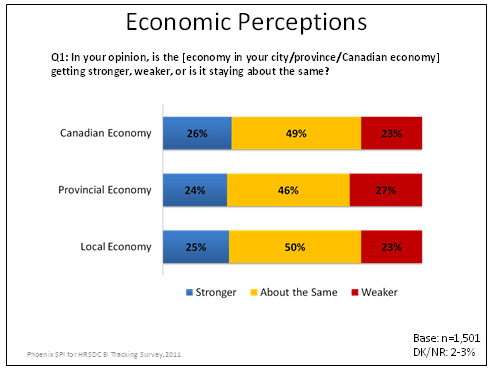
nc-por-rop-gd@hrsdc-rhdcc.gc.ca
Report Delivery Date: March 14th, 2011
POR Number: POR 086-10
Contract Number: G9178-100001/013/CY
Award Date: 2010-12-07
Contract amount: $77,317.43 (HST included)
Ce rapport est aussi disponible en français sur demande.
Phoenix SPI is a ‘Gold Seal Certified’ Corporate Member of the MRIA
Phoenix SPI was commissioned by Human Resources and Skills Development Canada (HRSDC) to conduct a survey with Canadians 18 years and older to explore issues related to the Employment Insurance (EI) Program. The results will be used by HRSDC to better understand public perceptions of the program and to help identify policy considerations related to recommendations and proposals made by various stakeholders to reform aspects of the program. This study tracks data from similar surveys conducted from 1998 to 2010.
For this year’s study, a dual-mode research methodology was used – a telephone survey and an online survey. The telephone survey was completed by 1,501 respondents January 12-31, 2011. Based on a sample of this size, the overall findings can be considered accurate to within ±2.6%, 19 times out of 20. This executive summary and the body of the report present the telephone results only. The online results are discussed in the detailed methodological note appended to this report.
Canadians offered decidedly mixed assessments of the economic outlook at the local, provincial, and national levels. Moreover, assessments of the economy at each level were very similar. The largest proportion – 46-50%, depending on the jurisdictional focus – felt that the economy is staying about the same, with most of the rest almost evenly split between optimistic and pessimistic assessments. Assessments of the national economy have changed relatively little over the past year. The proportion that thinks the national economy is stable has increased slightly (49% vs. 45% in 2010), as has the proportion that thinks it is weakening (23% vs. 20%), offset by a decrease in those who think the economy is getting stronger (26% vs. 32%).
Despite mixed assessments, a substantial majority (83%) of employed and self-employed respondents think it is unlikely that they will lose their job in the next year. However, as has been the case since 2009, fewer than half of these respondents are categorical about their job security (i.e. that they are not at all likely to lose their job).
Just over three-quarters of surveyed Canadians (76%) think that the EI program should offer longer benefits to those who have contributed to the program for many years (with two-thirds expressing strong agreement). Over two-thirds (71%) of employed respondents are confident they could access EI benefits if they were to lose their job. Between two-thirds and three-quarters of employed Canadians (68-74%) expressed confidence in their ability to access EI benefits in each of the studies conducted since 2001. Just over one-third (35%) believe the EI program is being abused by seasonal workers. Perceptions regarding abuse of EI by seasonal workers have changed very little since 2009.
Approximately half (49%) feel the EI program is fair. Over one-quarter (28%) were neutral, while almost one in five (19%) think the program is unfair. The proportion of Canadians who think the EI program is fair has increased slightly since last year, halting the decline in the proportion who view the program as fair evident since 2007. Those who described the EI program as unfair most often pointed to eligibility rules to explain why (28%).
Half think the level of income support provided by the EI program is adequate, with an additional 5% describing it as generous; 37% think it is insufficient. When it comes to the duration of income support provided by the EI program for loss of employment, just over half of those surveyed (52%) think this is adequate, with an additional 6% describing it as generous. Most of the rest think it is insufficient (33%), while 9% are uncertain.
A majority of Canadians think the current EI program works well and needs only minor adjustments as problems arise (59%). However, one-third see a need for major reforms. Those who think the EI program would benefit from changes (major or minor) were most likely to say that the benefit period should be expanded (16%), followed closely by increased benefit levels and expanded eligibility rules (14% each).
A majority of respondents (53%) said that if they were to lose their job and had a choice in how their EI benefits were paid, they would prefer a lower amount of benefits over more weeks. By contrast, 35% said they would prefer receiving a higher amount of benefits over fewer weeks. Five percent volunteered that their preference would depend on their situation at the time, 4% expressed no preference, and 4% did not know.
The largest proportion of respondents who work for an employer (41%) said they were not aware of short-term illness benefits available through the EI program, while an additional 14% said they have little awareness of such benefits. Conversely, 23% indicated that they are very aware of such benefits, while 21% are somewhat aware of them. Awareness of short-term illness benefits has fluctuated over time, and is at its lowest level since tracking began in 2007 (44% vs. 57% in 2010, 49% in 2009, 52% in 2008 and 47% in 2007).
Almost one-quarter of Canadians said that over the past 10 years they have been absent from work for more than two weeks due to a short-term illness or injury that required a doctor’s certificate. Two-thirds of these indicated that they received income support during their absence, while 32% said they did not. Income support during absence from work due to illness or injury came primarily from three sources: an employer’s disability plan (35%), EI sickness benefits (30%) and sick leave with pay (29%).
Almost half of Canadians (49%) say they are somewhat or very aware of income benefits available to individuals who need to take time off work to care for a gravely ill or dying family member. Of the rest, 38% are not at all aware, and 12% are not very aware of the availability of such benefits. Just over half (53%) said they would be very likely to apply for Compassionate Care benefits if they were faced with a situation in which the need for such benefits arose. Another quarter (26%) said they would be somewhat likely to do so.
Just over three-quarters of Canadians (77%) are unaware that the Government of Canada has passed legislation providing EI Maternity, Parental, Sickness, and Compassionate Care benefits to self-employed Canadians on a voluntary basis. Ten percent claim to be definitely aware of this, and a further 12% claim to be vaguely aware of it. Lack of awareness of this legislation is higher than it was last year (77% vs. 72% in 2010).
Half of the self-employed individuals (n=200) said they do not intend to opt into the EI program to take advantage of this new measure for the self-employed. Nearly one-third (32%) said they would and 18% did not know. Among self-employed respondents who intend to opt into the EI program (n = 62), the main reason given to explain why is the peace of mind that comes from having insurance (73%). Among self-employed respondents who do not intend to opt into the EI program (n=101), the main reason given to explain why is lack of need (32%). Caution should be exercised in interpreting these results due to the relatively small numbers of self-employed respondents who intend to act one way or another regarding the EI measures.
Well over half of Canadians (62%) were unaware of the work-sharing adjustment program under the EI program designed to help employers and employees avoid temporary layoffs. The rest were almost evenly divided between those who claimed to be definitely aware of it (19%), and those who claimed to be vaguely aware of it (18%).
Interest in the work-sharing program was relatively widespread. Two-thirds of surveyed Canadians (67%) said they would be very interested in taking training to improve their skills if they were receiving EI because they lost their job. Another 17% said they would be moderately interested in this. Conversely, 7% said they would have little interest in this, and 8% expressed no interest at all. Among respondents who expressed little or no interest in skills training (n=220), the main reason given to explain why was their age and/or proximity to retirement (33%).
A majority of Canadians (61%) think the EI Program responded well in terms of helping people who lost their jobs during the recent recession. That said, they were much more likely to think it responded moderately well (47%) than very well (14%). On the other hand, 10% think the EI program did not perform very well, and 5% think it did not perform well at all. One-quarter (24%) were uncertain and did not provide an assessment.
Respondents who felt that the EI program did not perform well during the 2008/09 recession (n=216) identified a variety of ways in which the program could have performed better. Leading the way was making it easier to qualify for EI benefits (21%), followed by shorter wait times to receive benefits (16%), more training opportunities (15%), and paying higher benefits and benefits over a longer period of time (11% each).
Supplier Name: Phoenix Strategic Perspectives Inc.
PWGSC Contract Number: G9178-100001/013/CY
Award Date: 2010-12-07
Contact Person: Alexandra Hickey
To obtain more information on this study, please email nc-por-rop-gd@hrsdc-rhdcc.gc.ca.
Phoenix SPI was commissioned by Human Resources and Skills Development Canada (HRSDC) to conduct the 2011 Employment Insurance Tracking Survey.
Given that the Employment Insurance (EI) program was put through a major test during the recession, there was a strong need to continue annual tracking of public attitudes on various aspects and elements of the EI program to ensure that it remains responsive to the needs of workers. In addition, due to the changing nature of work occurring in the Canadian labour market, there was a need to continue annual tracking of public attitudes on various aspects and elements of the EI program to ensure that the program remains responsive to the needs of workers and employers. In particular, evidence obtained is used to support and develop policy recommendations and considerations. The annual nature of the survey allows for longitudinal insight to help identify emerging policy issues by tracking incremental changes in the perspectives of Canadians.
The EI program was also a key feature of the Government’s strategy to help Canadians affected by the global economic downturn as part of Canada’s Economic Action Plan. The EI Tracking Survey provides insight into the views and perceptions of Canadians on the economy and regarding whether and how well the EI program is supporting Canadian workers affected by the economic context of the time. It also provides insight into the views and perceptions of Canadians on potential areas for future policy development.
In 2009, the federal government passed legislation, the Fairness for the Self-Employed Act, which provides EI special benefits (maternity, parental/adoption, sickness and compassionate care benefits) to self-employed Canadians on a voluntary basis. As a result, self-employed individuals have been able to opt-in to the EI program since January 31, 2010, with benefits beginning to be paid in January 2011. Awareness and perceptions of these initiatives required tracking alongside baseline questions to provide longitudinal insight into how the changing economic context and nature of work occurring in the labour market impacts Canadians’ broad perspectives, program experiences and needs.
The EI Tracking Survey will help assess the views and perceptions of Canadians regarding whether and how well the EI program is helping Canadian workers adjust to changing labour market conditions and in supporting employment transitions. Data collected through the survey will be used by the department to help identify policy considerations related to recommendations and proposals made by various stakeholders (i.e. standing committees, labour and business organizations, think tanks, etc.) to adjust aspects of the program. The tracking of EI issues has been an ongoing activity since 1998.
Topics addressed in this year’s survey included the following:
In addition to the foregoing, HRSDC looked for a methodology that does not rely solely on traditional telephone research due to declining response rates and an increasing number of cell-phone-only households. The proposed methodology (see below) took this into consideration.
A dual-mode research methodology was used to meet the objectives of this study – a telephone survey and an online survey. The dual-mode research methodology is an approach that provides HRSDC with reliable, tracking data from the telephone sample, as well as learning vis-à-vis the potential transition of this research from telephone to online data collection in future. In addition, the telephone survey included cell phones in the sample frame to address the increasing incidence of cell-phone-only households in Canada.
A telephone survey was conducted with 1,501 members of the general public, 18 years of age and older. Based on a sample of this size, the overall findings can be considered accurate to within ±2.6%, 19 times out of 20. The margin of error for sub-sets of this population is higher. As well, the following applied to the telephone survey:
The following specifications to the telephone survey:
As well, an online panel survey was conducted with Canadian residents, 18 years of age and older. This research was undertaken to determine whether moving the survey to an online method of data collection would be a viable option for the future. In total, 501 respondents completed the online survey. Since this was not a probability sample, no margin of error can be applied to the research results. The following specifications applied to the online survey:
Caveat regarding tracking of results: When comparing results over time, it should be kept in mind that the sample for this year’s telephone survey differed from the sample in previous waves in that 20% of this year’s sample consisted of cell phone numbers.
A more detailed methodological note is appended to this report, as is a copy of the telephone questionnaire in both official languages.
This section explores Canadians’ perceptions of the economy, as well as related issues.
Canadians offered decidedly mixed assessments of the economic outlook at the local, provincial, and national levels. Moreover, assessments of the economy at each level were very similar. The largest proportion – 46-50%, depending on the jurisdictional focus – felt that the economy is staying about the same, with most of the rest almost evenly split between optimistic and pessimistic assessments.

Text description of Figure 1 Economic Perceptions
Assessments of the national economy have changed relatively little over the past year, especially if compared to perceptions that accompanied the economic downturn of 2009. The proportion that thinks the national economy is stable has increased slightly compared to last year (49% vs. 45% in 2010). The proportion that thinks it is weakening has also increased slightly (23% vs. 20%), and there has been a decrease in the proportion that thinks the economy is getting stronger (26% vs. 32%). Perceptions of the national economy in the two years following the economic downturn are more in line with what they were between 2003 and 2008.
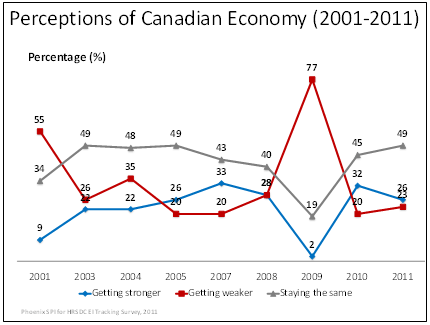
Text description of Figure 2 Perceptions of the Canadian Economy (2001-2011)
A substantial majority (83%) of employed and self-employed respondents1 (n = 805) think it is unlikely that they will lose their job in the next year (with close to half describing this as not at all likely). Conversely, 12% viewed this as somewhat or very likely.
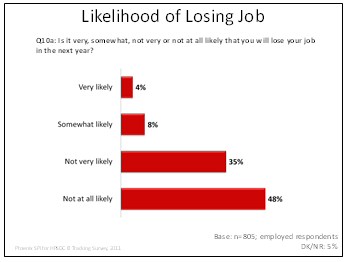
Text description of Figure 3 Likelihood of Losing Job
As has been the case since 2009, fewer than half the employed respondents are definite about their job security (i.e. that they are not at all likely to lose their job). That said, compared to last year there has been a decrease in the proportion of respondents who think their job is not secure (12% thinking they are somewhat or very likely to lose their job in the next year vs. 18% in 2010).
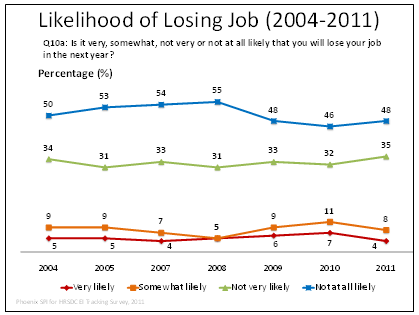
Text description of Figure 4 Likelihood of Losing Job (2004-2011)
Of those who think it is at least somewhat likely that they will lose their jobs in the next year (n = 96)2, close to half (44%) think that if this were to happen it would be in the latter half of the next year. Almost as many (42%) think it would be within the next six months.
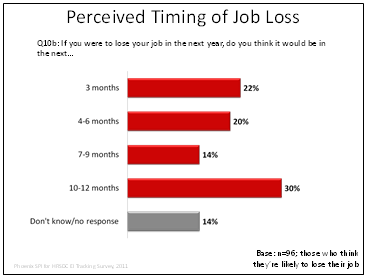
Text description of Figure 5 Perceived Timing of Job Loss
Likelihood of Taking Action if Job Lost
Employed Canadians who said they were at least somewhat likely to lose their jobs during the next year (n = 96) were asked how likely they would be to do each of the following if they did lose their job:
The proportions indicating that they would be likely to undertake these measures varied considerably. Just over half (52%) said they would be likely to find a new job where they live, as good as or better than their current job within 12 months. Close to half (44%) said they would be likely to try to start their own business or become self-employed. Just over one-quarter (27%) said they would be likely to move to seek employment in their occupation in another location in Canada or move to seek employment in a different occupation in another location in Canada.
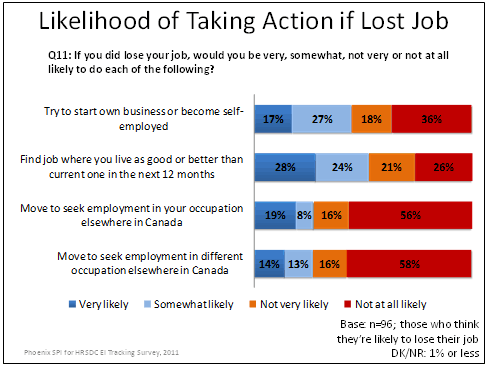
Text description of Figure 6 Likelihood of Taking Action if Lost Job
Looked at another way, majorities said they were unlikely to do three of these four actions. Approximately three-quarters said they were unlikely to move, whether to seek employment in their occupation (72%) or in a different occupation (74%). Moreover, clear majorities were definite that they would not undertake either of these two measures. Over half (54%) said they would be unlikely to try to start their own business or become self-employed, with over one-third (36%) saying it was not at all likely that they would do this.
For the first time in two years, a majority of employed Canadians who said they were at least somewhat likely to lose their jobs during the next year think it likely that they would find a new job where they live (should they lose their current job) as good or better than their current job. The proportion that thinks they are likely to start a business or become self-employed is also higher than it was in 2009 and 2010. On the other hand, the proportions who think they are likely to move to find employment in the same occupation or a different occupation are the lowest they been since tracking began.
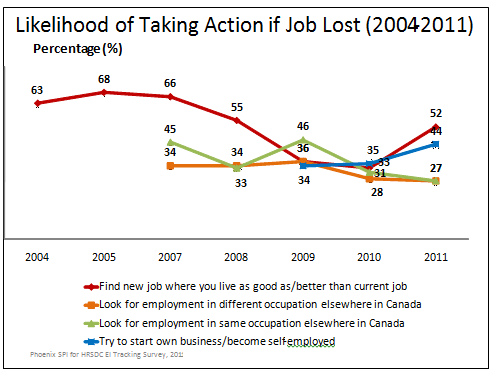
Text description of Figure 7 Likelihood of Taking Action if Lost Job (2004-2011)
This section explores respondents’ use, perceptions, and knowledge of the Employment Insurance (EI) program.
In total, 28% of surveyed Canadians said they received EI benefits at some point in the last five years. More specifically, 15% received benefits only once in the past five years, 9% received them 2-3 times, and 4% received them four or more times.
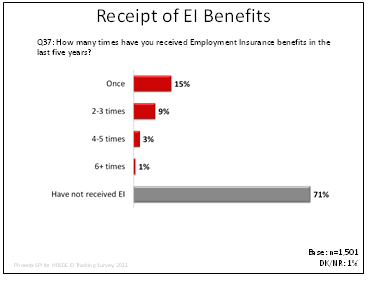
Text description of Figure 8 Receipt of EI Benefits
Among those who received EI benefits in the last five years (n = 418), job loss was the reason cited most often (46%). This was followed, at a distance, by maternity leave (16%), illness (13%), lay-off/shortages of work due to the nature of employment (11%), seasonal work (9%), parental leave (4%), contract termination (3%), returning to school or an apprenticeship program (3%), moving (2%), and injury/disability (2%).
Included in the ‘other’ category are bankruptcy and Compassionate Care benefits.

Text description of Figure 9 Reasons for Receiving EI Benefits
Job loss remains the main reason for receiving EI benefits, and the likelihood of identifying it has remained relatively steady during the last couple of years (46% vs. 49% in 2010, 45% in 2009, and 42% in 2008).
The large majority (83%) of those who received EI benefits within the last five years due to job-loss (including work shortage, seasonal work, or contract termination) said they did not move to try to find work while receiving benefits. Conversely, 17% said they did.
The proportion saying they moved to try to find work is slightly higher than in previous years (17% vs. 13% in 2008, 2009, and 2010).
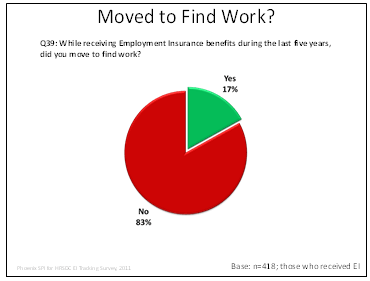
Text description of Figure 10 Moved to Find Work?
Eighteen percent of respondents reported that someone else in their household received EI benefits during the last five years. Nearly all the rest (80%) said no one received these benefits, while 2% did not provide a response or said the question did not apply to them.
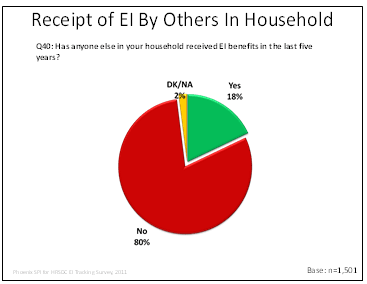
Text description of Figure 11 Receipt of EI by Others in Household
Results are virtually identical to those between 2008 and 2010.
Job loss also emerged as the most likely reason for others in the household receiving EI benefits. Forty-seven percent of respondents who said someone else in their home had received EI benefits (n = 265) said it was because of job loss. This was followed, in declining order of frequency, by maternity leave (13%), illness (12%), seasonal work (11%), lay-off/shortage of work due to type of employment (10%), parental leave (6%), Compassionate Care benefits (3%), returning to school or an apprenticeship program (2%), and an injury/disability (2%).
Included in the ‘other’ category are bankruptcy and contract termination. Results are very similar to those of previous years (i.e. 2008-2010), though the proportion identifying maternity is the lowest it has been (13% vs. 20% in 2010, 18% in 2009, and 16% in 2008).
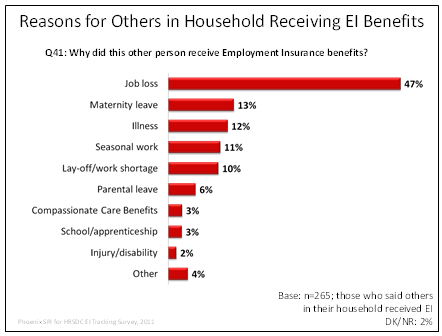
Text description of Figure 12 Reasons for Others in Household Receiving EI Benefits
Respondents were asked to rate their level of agreement with the following three statements about the EI program (using a 7-point scale: 1 = strongly disagree, 7 = strongly agree):
Just over three-quarters of all respondents (76%) agreed that the EI program should offer longer benefits to those who have contributed to the program for many years (with two-thirds expressing strong agreement). The rest were almost equally divided between neutrality (11%) and disagreement in response to this statement (10%). Among employed respondents (n = 805), 71% said they are confident they could access EI benefits if they were to lose their jobs (62% expressed strong agreement). Conversely, 15% disagreed, while 12% were neutral. Perceptions were almost evenly divided for the statement that too many people stay in seasonal jobs to collect benefits: 35% agreed, 30% disagreed, and 32% provided a neutral response to this statement.
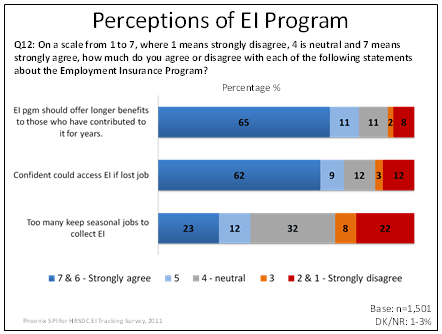
Text description of Figure 13 Perceptions of EI Program
Between two-thirds and three-quarters of Canadians (68-74%) have expressed confidence in their ability to access EI benefits in each of the studies conducted since 2001. The level of strong confidence has varied by no more than six percentage points since tracking began (i.e. between 60% and 66%).
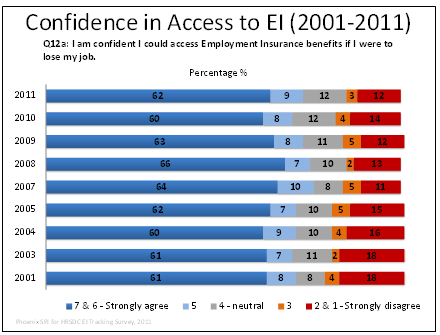
Text description of Figure 14 Confidence in Access to EI (2001-2011)
Perceptions regarding abuse of EI by seasonal workers have changed very little since 2009. Over the past decade of tracking, the proportion of respondents who agree that too many people stay in seasonal jobs to collect benefits has declined gradually, from close to half to approximately one-third.
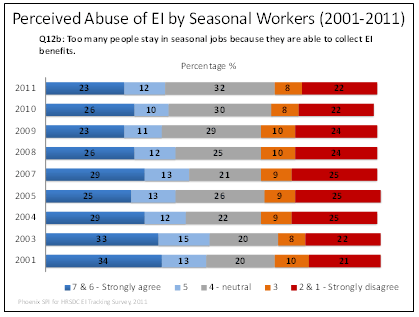
Text description of Figure 15 Perceived Abuse of EI by Seasonal Workers (2001-2011)
Just under half of respondents said they feel the EI program is somewhat (35%) or very fair (14%). Over one-quarter (28%) were neutral on this, while almost one in five think that the program is unfair (19%).
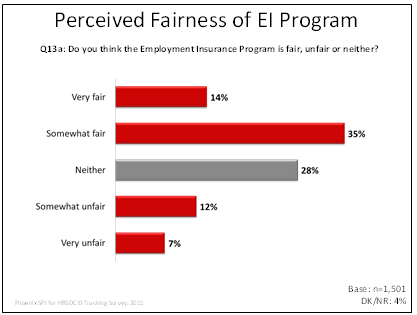
Text description of Figure 16 Perceived Fairness of EI Program
The proportion of Canadians who think the EI program is fair has increased slightly since last year, halting the decline in the proportion who view the program as fair evident since 2007. The proportion that perceives the EI program to be unfair has decreased by 6% compared to last year, halting the increase in the proportion who view the program as unfair evident since 2007.
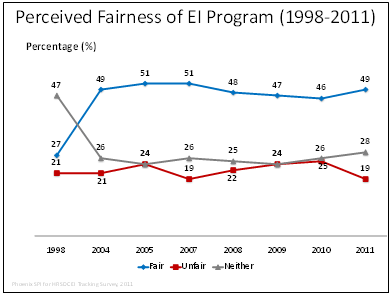
Text description of Figure 17 Perceived Fairness of EI Program (1998-2011)
Respondents who described the EI program as unfair (n = 312), most often pointed to eligibility rules to explain why (28%). This was followed by the perception that some people have to pay premiums but cannot collect benefits (18%). Ten percent each pointed to insufficient benefits, the length of time during which one can receive benefits, and the impression that the system is easy to abuse, while 7% cited the two-week waiting period, and 6% aspects not taken into consideration when determining benefits.
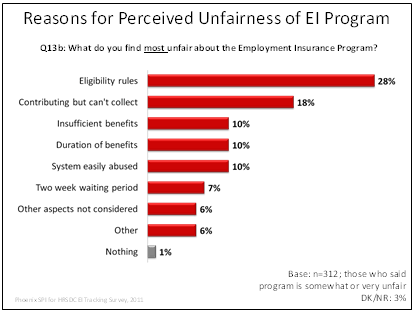
Text description of Figure 18 Reasons for Perceived Unfairness of EI Program
Included in the ‘other’ category are the absence of coverage for self-employed workers, basing benefits on level of income, insufficient funding for training considerations, inconsistent distribution of benefits across provinces, and the size of the surplus.
Half of those surveyed said the level of income support provided by the EI program is adequate, with an additional 5% describing it as generous. Most of the rest identified the level of income support as insufficient (37%), while 8% said they did not know or did not provide a response.

Text description of Figure 19 Perceptions of Income Support Level
Since 2007, the number of Canadians who think the level of support is adequate varied moderately, ranging from 46-51%.

Text description of Figure 20 Perceptions of EI Support Amounts (2007-2011)
Perceptions of the duration of EI benefits were similar to perceptions of the level of income support. Just over half of those surveyed (52%) said the duration of income support provided by the EI program is adequate, with an additional 6% describing it as generous. Most of the rest identified the duration of income support as insufficient (33%), while 9% said they did not know or did not provide a response.
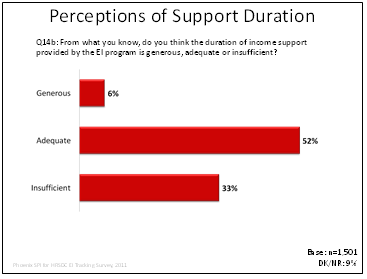
Text description of Figure 21 Perceptions of Support Duration
A majority of respondents think that the current EI program works well and needs only minor adjustments as needs arise (59%). By contrast, one-third see a need for major reforms. Two percent said it needs neither.
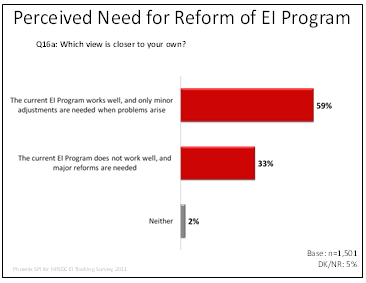
Text description of Figure 22 Perceived Need for Reform of the EI Program
Since 2009, there has been a slight increase in the proportion saying the program is working well and in need of only minor adjustments (59% vs. 56% in 2010, and 54% in 2009), and a corresponding decrease in the proportion feeling the EI program requires major reforms (33% vs. 35% in 2010, and 37% in 2009).
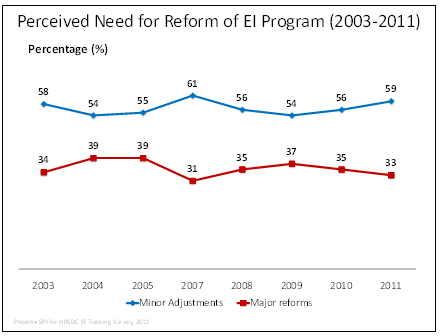
Text description of Figure 23 Perceived Need for Reform of the EI Program (2003-2011)
Respondents who think the EI program would benefit from changes (major or minor) were most likely to say that the benefit period should be expanded (16%), the level of benefits should be increased (14%), and eligibility should be expanded (14%) (multiple responses accepted). This was followed by suggestions for reducing wait times and cracking down on abuse (8% each), providing more benefits to those who have contributed longer (6%), providing more/better training and re-training programs, and providing help/incentives to get people back to work (5% each).
Smaller and similar numbers (3-4%) see a need to review each claimant’s situation individually to better meet his/her needs, restrict eligibility, increase benefits for self-employed, part-time, and seasonal workers, and increase the EI surplus.
Included in the ‘other’ category are ensuring consistency in benefits across regions, taking other aspects into consideration when assessing claims, ensuring benefit levels are proportionate to income level, increasing benefits for people who have lost their job, increasing the amount of premiums paid by employers and/or employees, reducing the amount of premiums paid by employers and/or employees, and reducing the EI surplus.
One-quarter of these respondents said they do not know what changes should be made.
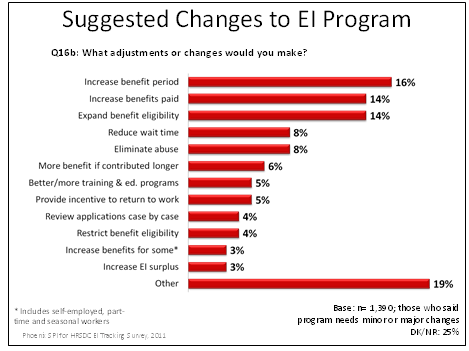
Text description of Figure 24 Suggested Changes to EI Program
While there has been some fluctuation over time, suggested adjustments have not changed noticeably since 2005. The most noticeable change is the increase over the past two years in the proportion suggesting increasing/expanding the benefit period (16% vs.19% in 2010, 6% in 2009, and 3% in 2008).
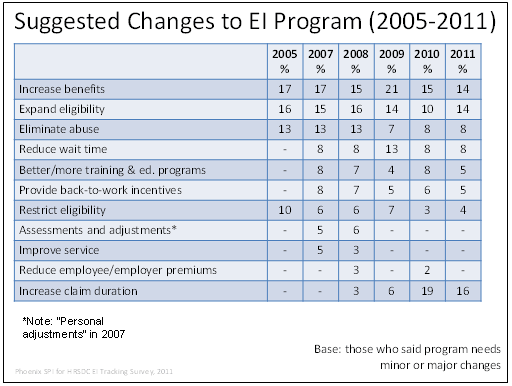
Text description of Figure 25 Suggested Changes to EI Program (2005 – 2011)
A majority of respondents (53%) indicated that if they were to lose their job and had a choice in how their EI benefits were paid, they would prefer a lower amount of benefits over more weeks to a higher amount of benefits over fewer weeks. By contrast, just over one-third (35%) indicated that they would prefer receiving a higher amount of benefits over fewer weeks. Five percent volunteered that their preference would depend on their situation, four percent said they have no preference, and four percent did not know.
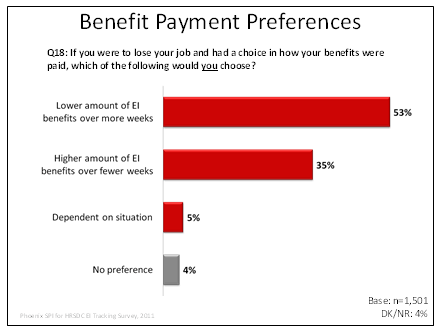
Text description of Figure 26 Benefit Payment Preferences
Since 2007, there has been a steady decline in the proportion favouring a higher amount of benefits over fewer weeks. Conversely, the proportion favouring a lower amount over more weeks has increased significantly, from 35% in 2007 to 53% in 2011.
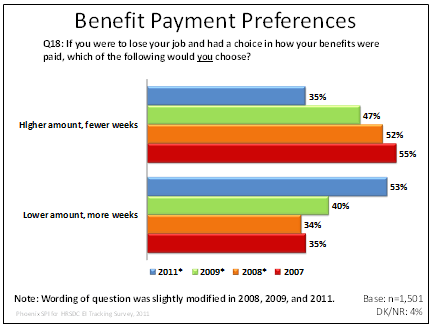
Text description of Figure 27 Benefit Payment Preferences
This section presents respondent perceptions of issues related to Sickness benefits.
The largest proportion of respondents who work for an employer (41%) indicated that they have no awareness of short-term illness benefits available through the EI program, while an additional 14% said they have little awareness of such benefits. Conversely, 23% indicated that they are very aware of such benefits, and 21% said they are somewhat aware of them.

Text description of Figure 28 Awareness of Sickness Benefits
Awareness of short-term illness benefits has fluctuated over time, and is at its lowest level since tracking began (44% vs. 57% in 2010, 49% in 2009, 52% in 2008 and 47% in 2007).

Text description of Figure 29 Awareness of Short-Term Illness Benefits (2007-2011)
Almost one-quarter of respondents indicated that over the past 10 years they have been absent from work for more than two weeks due to a short-term illness or injury that required a doctor’s certificate. Results have changed little since 2007.
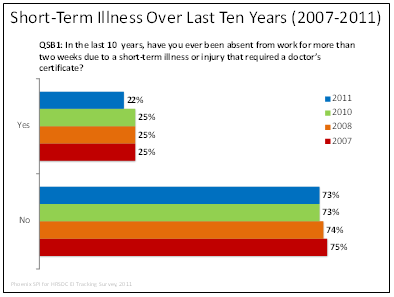
Text description of Figure 30 Short-Term Illness Benefits over Last 10 Years (2007-2011)
The length of time respondents were away from work varied. Over half of them (56%) were away from work for at least seven weeks. Most of the rest, one-quarter, were away for 3-4 weeks. A small number (3%) indicated that they have not yet returned to work.
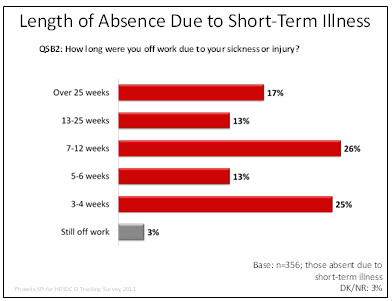
Text description of Figure 31 Length of Absence Due to Short-Term Illness
The proportion of respondents who were away from work for at least 13 weeks due to a short-term illness or injury that required a doctor’s certificate has declined since 2008 (30% vs. 36% in 2010 and 40% in 2008).
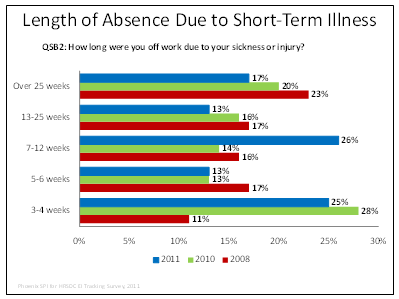
Text description of Figure 32 Length of Absence Due to Short-Term Illness
Two-thirds of those who have been absent from work for more than two weeks due to an illness or injury indicated that they received income support during their absence.
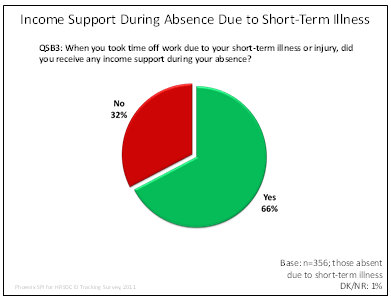
Text description of Figure 33 Income Support During Absence for Short-Term Illness
Results are similar to what they were last year.
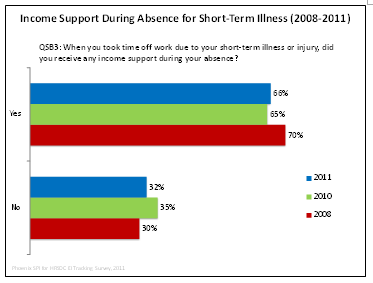
Text description of Figure 34 Income Support During Absence for Short-Term Illness (2008 to 2011)
Income support during absence from work due to illness or injury came primarily from three sources: an employer’s disability plan (35%), EI sickness benefits (30%) and sick leave with pay (29%) (multiple responses accepted). Also mentioned relatively frequently were Worker’s Compensation (22%), and regular pay continued by the employer (21%). This was followed, in descending order of frequency, by leave without pay (9%), an informal arrangement with an employer (8%), CPP disability benefits (7%), a personal disability plan and working fewer hours (5% each). Included in the ‘other’ category are personal savings and unspecified insurance plans.

Text description of Figure 35 Source of Short-Term Illness Income Support
This section presents respondent perceptions of issues related to Compassionate Care benefits.
Almost half of surveyed Canadians (49%) said they are at least somewhat aware of income benefits available to individuals who need to take time off work to care for a gravely ill or dying family member. Of the rest, 38% said they were not at all aware of such benefits, and 12% said they are not very aware of them.
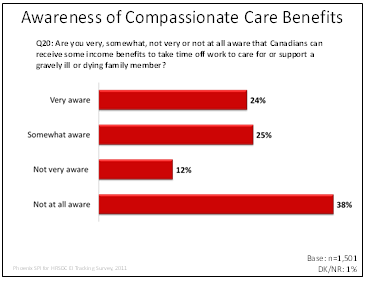
Text description of Figure 36 Awareness of Compassionate Care Benefits
Awareness of Compassionate Care benefits is lower than it was last year, and has fluctuated since 2009.
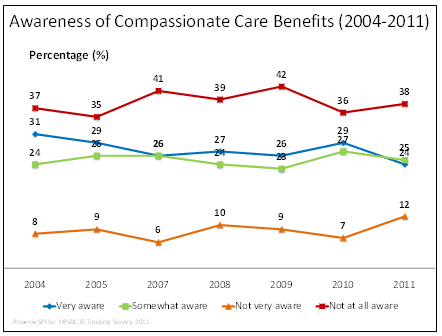
Text description of Figure 37 Awareness of Compassionate Care Benefits (2004-2011)
The large majority of respondents have never been in a situation in which their job demands came into conflict with the need to provide care for someone. Among those who have, this most often involved one-time medical emergencies (16%), followed closely by being called upon to provide care or support for someone who was gravely ill or dying (15%), and having to take care of someone with a chronic or long-term illness (13%).
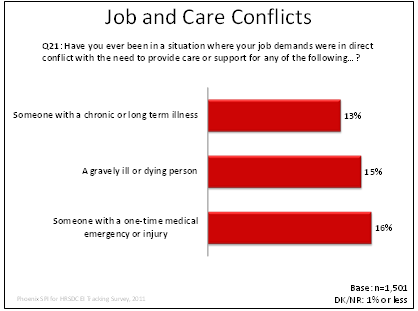
Text description of Figure 38 Job and Care Conflicts
The proportion of respondents reporting involvement in each of these situations is higher than last year, though results have changed little since 2007 when tracking began.
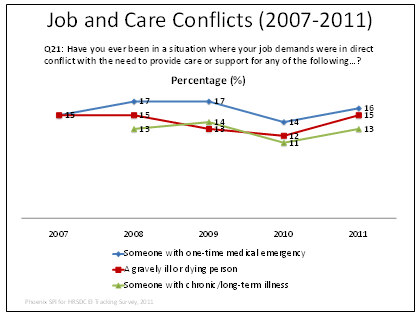
Text description of Figure 39 Job and Care Conflicts (2007-2011)
Of those who have experienced conflicts between job demands and the need to care for a very ill or dying person (n = 406), close to one-quarter (22%) identified the person cared for as a child under 18 years of age.

Text description of Figure 40 Job and Care Conflicts
Three-quarters of those who cared for a child under 18 years of age identified themselves as the child’s parent.
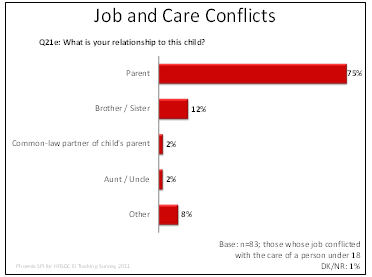
Text description of Figure 41 Job and Care Conflicts
Of those who have experienced conflicts between job demands and the need to provide care for someone (n = 406), over half (59%) said they took time off work to accommodate that need.
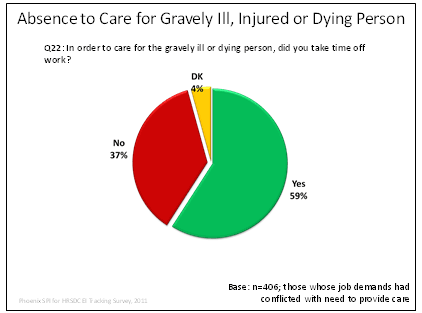
Text description of Figure 42 Absence to Care for Gravely Ill, Injured, or Dying Persons
The proportion of Canadians who reported taking time off work in order to care for someone is the lowest it has been since tracking began in 2005, and has been declining gradually since 2009.
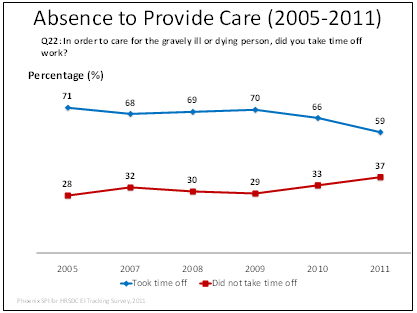
Text description of Figure 43 Absence to Provide Care (2005-2011)
Respondents who have been in a situation where they needed to care for an ill, injured, or dying person but who did not take time off work (n = 149) were most likely to say that the person was cared for by professional caregivers (49%). This was followed by 24% who said that an unemployed person provided care, 15% who said someone working part-time provided care or that someone else took time off from their work to care for this person, and 14% who said they found time to care for this person even though they did not take time off work (multiple responses accepted).
Five percent said that a number of people were involved in providing care at different times. Included in the ‘other’ category are relatives and someone having to quit their job to provide care.

Text description of Figure 44 Source of Care for Person
Tracking of this question over time is problematic due to the relatively low incidence of respondents who have found themselves in this situation. However, the data has been consistent insofar as care by a professional or through an institution is the most common solution found by those who did not take time off work for this (49% in 2011, 57% in 2010, 47% in 2009, 51% in 2008, 48% in 2007, and 58% in 2005).
Among those who took time off to care for a gravely ill, injured or dying person (n = 243), close to half (48%) took at least two weeks away from work (29% took 2-6 weeks, and 19% took seven weeks or more). Almost as many (49%) took less than two weeks. One percent volunteered that care is still ongoing.

Text description of Figure 45 Length of Absence to Provide Care
Given the relatively small number of respondents who faced such a situation, the accuracy of conclusions drawn from the tracking data is limited. However, data for the period between 2005 and 2010 indicates that most people who find themselves in this situation end up taking less than seven weeks off work. In addition, the proportion of respondents taking less than two weeks off has increased since 2009, after having declined between 2007 and 2009 (49% in 2007, 41% in 2008, 29% in 2009, 35% in 2010, and 49% in 2011).
Most those who took time off to care for an ill, injured, or dying person (73%) took some form of paid leave, including vacation time (27%), general leave with pay (18%), family leave (17%), or sick leave (11%) (multiple responses accepted).
Not surprisingly given that most respondents’ absences from work were fairly short, the largest single proportion of those who did take time off took leave without pay (41%), while one-third (34%) made informal arrangements with their employer. One-quarter worked fewer hours and one in ten quit their jobs, while smaller numbers applied for and received Compassionate Care benefits under the EI program (6%) or changed their job (5%).
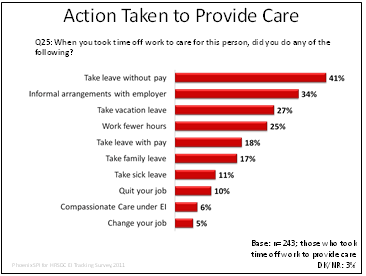
Text description of Figure 46 Action Taken to Provide Care
Taking leave without pay has been the most frequent approach taken since tracking began (41% in 2011, 47% in 2010, 43% in 2009 and 40% in 2008). The likelihood of working fewer hours has increased over time (25% vs. 24% in 2010, 19% in 2009 and 18% in 2008).
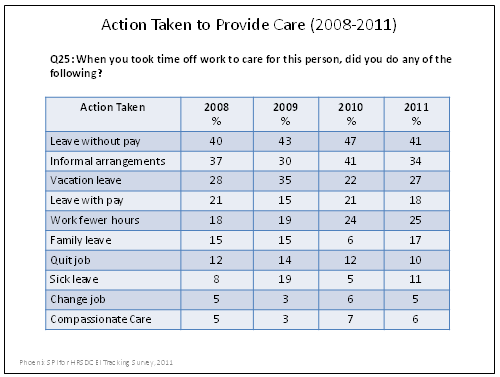
Text description of Figure 47 Action Taken to Provide Care (2008-2011)
Of those who did not use Compassionate Care benefits during their time away from work to care for a gravely ill or dying person, about half (51%) said they did not use them because they did not know about them. Other reasons were identified infrequently and include the fact that their situation occurred before such benefits were available (7%), obtaining paid leave (6%) and only having to take work leave for a short period of time (6%), the impression that the benefits were unnecessary (5%), and uncertainty about qualifying for these benefits (5%).
Very small numbers (3%) identified the impression that the replacement rate for income was inadequate, being ineligible because they were self-employed, and not contributing to EI. Included in the ‘other’ category are the impression that these benefits would not arrive in time, the impression that the duration of benefits would be inadequate, and the perceived difficulty of applying for the benefits.
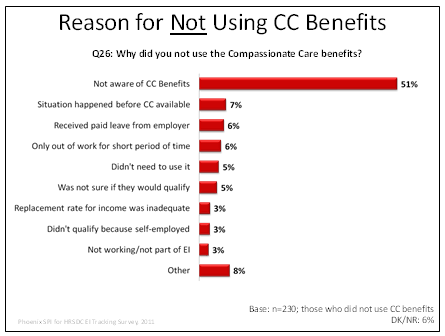
Text description of Figure 48 Reason for not using CC Benefits
Lack of awareness of these benefits has fluctuated over time, but has consistently been the main reason, by far, for not using Compassionate Care benefits. Reference to the fact that a situation occurred before such benefits were available is lower this year than in previous years (7% vs. 12% in 2010 and 2009, 19% in 2008, and 17% in 2007).
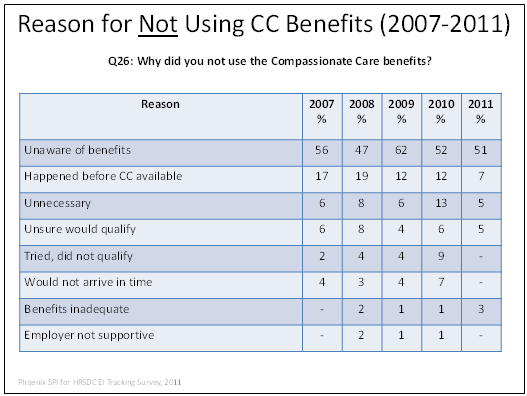
Text description of Figure 49 Reason for not using CC Benefits (2007-2011)
Over half of surveyed Canadians (53%) said they would be very likely to apply for Compassionate Care benefits if they were faced with a situation in which the need for such benefits arose. Another quarter (26%) said they would be somewhat likely to do so. Conversely, 8% said they would not be very likely to apply for such benefits, and 9% said they would be not at all likely to apply for them.

Text description of Figure 50 Likelihood of Using Compassionate Care Benefits
The proportion of respondents saying they would be at least somewhat likely to do this has fluctuated since 2005, but has not varied widely (from 75-81%). As well, majorities have said they would be very likely to do this since tracking began.
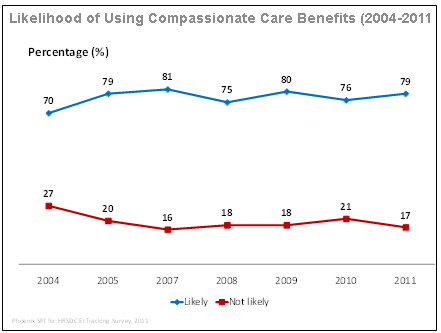
Text description of Figure 51 Likelihood of Using Compassionate Care Benefits (2004-2011)
Respondents who said they would likely not apply for Compassionate Care benefits in the future (n = 269) most often explained why by saying that the benefits would not be necessary (23%). This was followed by 13% who said that their employee benefits would provide sufficient coverage, and 12% who said that they are not paying EI (multiple responses accepted).
A host of reasons were identified by smaller numbers, including the following: the impression that it would be too much of a hassle, and being at retirement age (6% each), being unable or not wanting to take time off work (5%), uncertainty about qualifying and lack of financial need (4% each), the impression that such benefits would be inadequate and having insufficient details about them (3% each), and being against the idea in principle and being self-employed (2% each).
Included in the ‘other’ category is the impression that benefits would have to be repaid at a later date, and that the waiting period for receipt of benefits would be long. Two percent said there was no reason, while 11% did not know or did not provide a response.
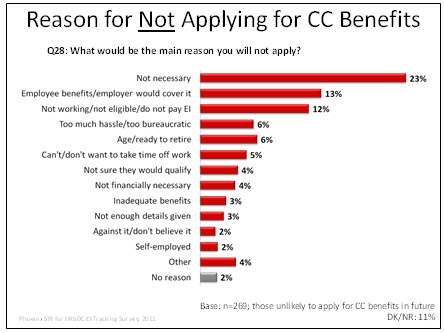
Text description of Figure 52 Reason for Not Applying for CC Benefits
The proportion of respondents identifying lack of need is higher than in previous years (23% vs. 16% in 2010, 15% in 2009,16% in 2008, and 13% in 2007).

Text description of Figure 53 Reason for Not Applying for CC Benefits (2007-2011)
This section presents respondent perceptions of issues related to Employment Insurance measures for self-employed people.
Just over three-quarters of Canadians (77%) were not aware that the Government of Canada had passed legislation providing EI Maternity, Parental, Sickness, and Compassionate Care benefits to self-employed Canadians on a voluntary basis. Ten percent claimed to be definitely aware of this, and a further 12% claimed to be vaguely aware of it.

Text description of Figure 54 Aware of Measure to Provide EI Benefits to Self-Employed
Lack of awareness of this legislation is higher than it was last year (77% vs. 72% in 2010).
Half of the self-employed individuals said they do not intend to opt into the EI program to take advantage of these new measures for the self-employed. Almost one-third (32%) said they would, and 18% did not know.
The proportion of self-employed who said they intend to opt into the EI program is significantly higher than it was last year (32% vs. 22% in 2010).

Text description of Figure 55 Do You Intend to Opt Into EI Program?
Among the self-employed who said they intend to opt into the EI program (n = 62), the main reason given to explain why was the peace of mind that comes from having insurance (73%). Other reasons were identified much less often and focused on the ability to access specific benefits. Leading the way was access to sickness benefits (13%), followed by Compassionate Care benefits (9%), parental benefits (3%), and maternity benefits (1%) (multiple responses accepted). Included in the ‘other’ category are disability/ injury benefits, and a desire for benefits in general. Nine percent did not know or did not provide an answer.

Text description of Figure 56 Primary Reason for Opting Into EI Program
Among self-employed respondents who said they do not intend to opt into the EI program (n = 101), the main reason given to explain why was lack of need (32%). This reason was identified three times as often as any other. It was followed at a distance by insufficient information about these measures (10%), the perception that premiums are too high (9%), and the impression that benefits are insufficient (8%) (multiple responses accepted).
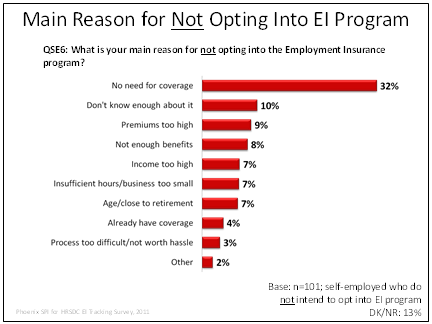
Text description of Figure 57 Main Reason for Not Opting Into EI Program
Equal numbers (7% each) pointed to their income being too high, their working an insufficient number of hours and/or their business being too small, and their age/being close to retirement. Very small numbers pointed to pre-existing coverage (4%), and the impression that the process is too difficult (3%). Included in the ‘other’ category is the perception that one cannot opt out of the program once a claim is made and being against it in principle. Thirteen percent did not know or did not provide an answer.
This section presents respondent perceptions of issues related to work sharing and training.
Well over half of Canadians (62%) were unaware of the work-sharing adjustment program under the EI program designed to help employers and employees avoid temporary layoffs. The rest were almost evenly divided between those who claimed to be definitely aware of it, and those who claimed to be vaguely aware of it.
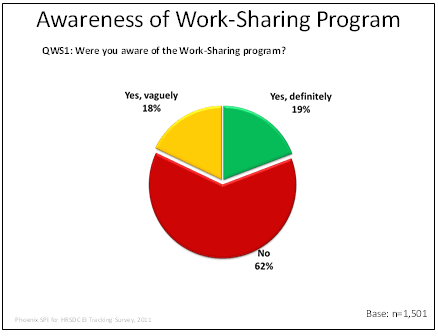
Text description of Figure 58 Awareness of Work-Sharing Program
Interest in training was relatively widespread. Two-thirds of surveyed Canadians said they would be very interested in taking training to improve their skills if they were receiving EI because they lost their job. Another 17% said they would be moderately interested in this. Conversely, 7% said they would have little interest in this, and 8% expressed no interest at all.
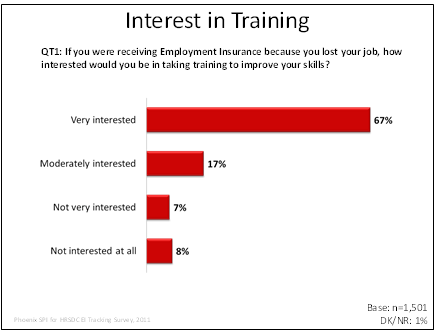
Text description of Figure 59 Interest in Training
Among respondents who expressed little or no interest in skills training (n = 220), the main reason given to explain why was their age and/or proximity to retirement. One-third pointed to this as the reason for their lack of interest. This was followed by a perceived lack of need for training (19%), confidence in their ability to find another job in their field (17%), and lack of interest in training courses offered (11%) (multiple responses accepted).
Small numbers (4% or less) identified the following reasons: the impression that training would take too long, lack of need, the fact they are currently taking training, the impression that it is too expensive, and the fact that they have a job and/or confidence that they will not lose it.
Included in the ‘other’ category are interference with other commitments, inability to move to take training, the possibility of returning to their previous job after EI runs out, and absence of guarantee that training would get them a job.

Text description of Figure 60 Reasons for Lack of Interest in Training
This section explores respondents’ impressions of the EI program in relation to the recession of 2008/09.
A majority of Canadians (61%) think that the EI Program responded well in terms of helping people who lost their jobs during the recent recession. That said, they were much more likely to think it responded moderately well (47%) than very well (14%). On the other hand, 10% think the EI program did not perform very well, and 5% think it did not perform well at all. One-quarter (24%) did not know or did not provide an assessment.

Text description of Figure 61 Perception of EI Program During Recession
Respondents who felt that the EI program did not perform well in the face of the 2008/09 recession (n = 216) identified a variety of ways in which the program could have performed better. Leading the way was making it easier to qualify for EI benefits (21%), followed by shorter wait times to receive benefits (16%), more training opportunities (15%), paying higher benefits and benefits over a longer period of time (11% each), providing more help finding a job, and better communication/providing more information (8% each) (multiple responses accepted).
Small numbers pointed to making the process easier in general (5%), and more flexibility/reviewing claims on a case by case basis. Included in the ‘other’ category are basing benefits on level of income, and more consistent distribution of benefits across provinces. One in five respondents did not know how the program could have responded better, or did not provide an answer.
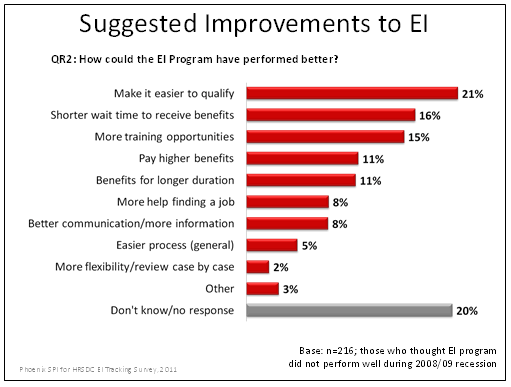
Text description of Figure 62 Suggested Improvements to EI
This section presents information about the employment status of survey respondents and explores related issues.
Well over half of those surveyed (62%) were employed at the time of the survey. Of these, 47% were employed workers, 10% were self-employed, and 5% were employed students. Of the rest, 17% were retired, 7% were unemployed, 4% were unemployed students, 4% said they are on disability, sick, parental or maternity leave, and 4% were homemakers.
Please note that the determination of respondents’ employment status for the purpose of analysis included responses to multiple questions.3
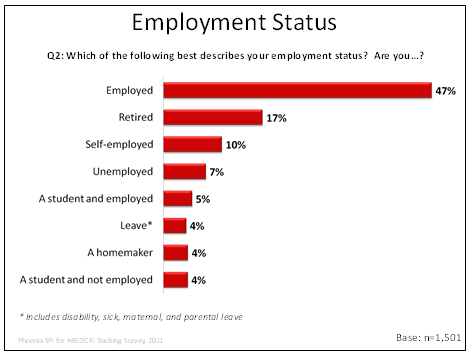
Text description of Figure 63 Employment Status
Of respondents who identified themselves as employed, unemployed or self-employed (n = 1,106), approximately one in ten (11%) said their employment is seasonal.
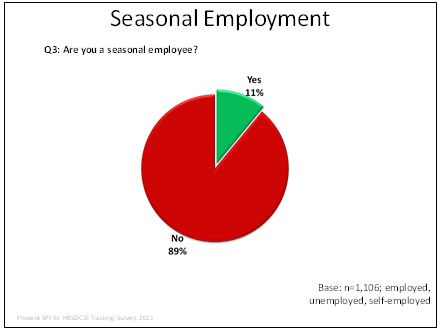
Text description of Figure 64 Seasonal Employment
Three quarters of employed and self-employed respondents (n = 986) said they work full-time, while most of the rest said they do so part-time (22%).

Text description of Figure 65 Type of Employment
Nearly three quarters of employed and self-employed respondents (72%) said that they work 35 or more hours per week. Almost equal proportions said they work between 21 and 34 hours per week (12%), and 20 hours or less per week (11%).
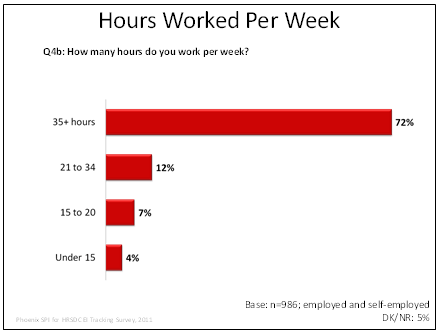
Text description of Figure 66 Hours Worked Per Week
The large majority of self-employed respondents (89%) identified self-employment as their main source of personal income.
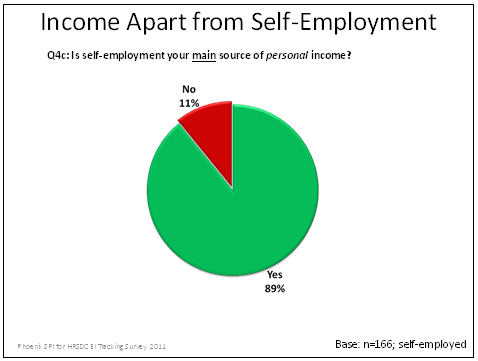
Text description of Figure 67 Income Apart from Self-Employment
Close to three-quarters of self-employed respondents (72%) said they have no employees, while 28% said they do.
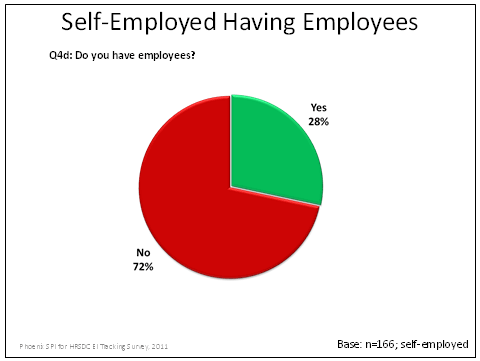
Text description of Figure 68 Self-Employed Having Employees
The length of time that self-employed respondents report having been self-employed varies. Over one-quarter said they have been self-employed for three years or less. Almost identical proportions said they have been self-employed for 4-5 years (14%), 6-10 years (13%), and 11-15 years (13%). Close to one-third said they have been self-employed for over 15 years, with almost one-quarter saying they have been self employed for over 20 years.

Text description of Figure 69 Duration of Self-Employment
The large majority of self-employed respondents (87%) said they do not have another job apart from their self-employment, while the rest (13%) said they do.
The vast majority of employed respondents (92%) said their employer deducts EI and CPP/QPP amounts from their pay.
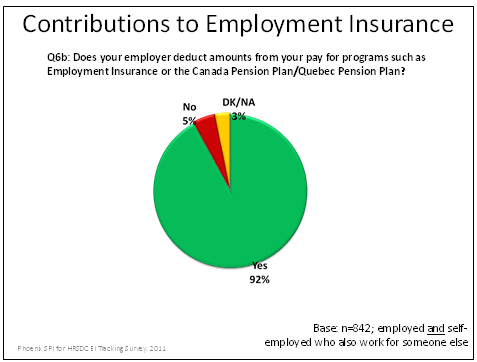
Text description of Figure 70 Contributions to Employment Insurance
Over three-quarters of employed respondents (78%) said they are not responsible for managing other employees. Nearly all the rest said that they do have management responsibilities.
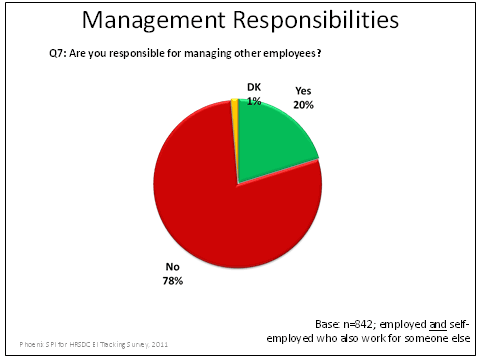
Text description of Figure 71 Management Responsibilities
Over half of all unemployed respondents and homemakers (57%) said they are looking for work, while nearly all of the rest (42%) indicated that they are not seeking employment.
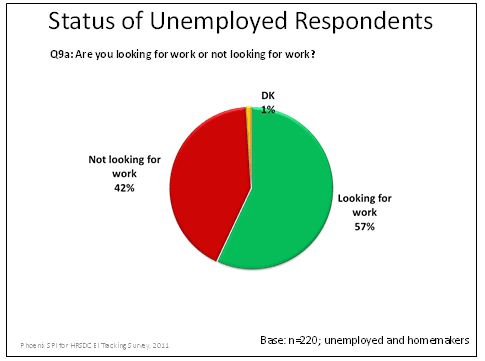
Text description of Figure 72 Status of Unemployed Respondents
A bare majority of unemployed respondents and homemakers looking for work (51%) estimated that they would be able to find work within three months. Close to one-quarter (22%) estimated that they could find work within 4-6 months, while 16% felt it would take at least seven months.

Text description of Figure 73 Estimated Time Needed to Find Work
This section presents subgroup differences for key issues explored in this survey. This includes variations based on region, age, employment status, education, language, rural-urban locations, household type (i.e. cell phone only, landline only, cell phone and landline), gender, and status regarding receipt of EI. For the analysis, characteristics have been grouped as follows:
Only differences that are significant at the 95% confidence level are reported (unless differences are indicative of a pattern).
State of the Economy
The following were more likely to think the economy at all levels is strengthening:
The likelihood of thinking that the economy, at all levels, is strengthening also increased with education:
As well, the likelihood of thinking that the economy at all levels is weakening, decreased with education.
Canadians 35 and older were also more likely to think the economy at all levels is weakening: locally (25% of those 35 and older vs. 18% of those under 35), provincially (28% of those 35-54 and 33% of those 55 and older vs. 21% of those under 35), and nationally (24-26% of those 35 and older vs. 17% of those under 35).
In addition,
Likelihood of Job Loss
The following were more likely to be certain that they will not lose their job in the next year:
A majority of respondents in all regions except Ontario and Quebec were certain that they will not lose their job in the next year (58% in B.C., 57% in the Atlantic region, 55% in the Prairies vs. 47% in Ontario and 37% in Quebec).
Previous Use of EI Benefits
The following were most likely to say they received EI benefits during the past five years:
As respondents increased in age, they were less likely to say that other members of their household received EI benefits in the last five years (from 27% of those under 35 to 9% of those 55 and older). The following were also more likely to say that other members of their household received EI benefits in the last five years:
When it came to reasons for receiving EI benefits, the likelihood of citing job loss was highest among the unemployed (64% vs. 41% of the employed), men (55% vs. 38% of women), and Anglophones (50% vs. 36% of Francophones). The likelihood of citing maternity leave decreased with age (from 24% of those under 35, to 16% of those 35-54, to 0% of those 55 and older), but increased with education (from 5% of those with high school or less to 37% of those with university education). It was also more likely to be cited by the employed than the unemployed (20% vs. 7%), and residents of urban areas (18% vs. 10% of residents of rural areas).
Illness was most likely to be cited by those 55 and older (25% vs. 12% of those 35-54 and 9% of those under 35). The likelihood of citing seasonal work decreased with education (from 15% of those with high school education or less to 2% of those with university education). It was also more likely to be identified by men (12% vs. 5% of women), and Francophones (15% vs. 6% of Anglophones).
Confidence in Availability of EI
Among Canadians who work for an employer, the following were more likely to be very confident that they could access EI benefits if they were to lose their job:
Perceived Abuse of EI Program by Seasonal Workers
The following were more likely to strongly disagree that too many people stay in seasonal jobs because they are able to collect EI benefits:
Those most likely to strongly agree with this included residents of the Atlantic region (26% vs. 13-19% elsewhere), and those with college education or less (18-19% of those with a college education or less vs. 12% of those with university education).
Perceptions regarding EI benefits for those who have contributed for many years
The following were more likely to strongly agree that the EI program should offer longer benefits to those who have contributed to the program for many years:
Perceived Fairness of EI Program
In only two regions did majorities think that the EI program is fair (53% of Atlantic residents and 52% of Ontario residents vs. 45-46% elsewhere). The perception that the EI program is not fair increased with age (from 14% of those under 35 to 23% of those 55 and older).
Perceptions of Support Amounts
Canadians under 35 were most likely to describe the level of income support provided by the EI program as adequate (61% vs. 46% of those 35 and older). Men were also more likely to think this (54% vs. 46% of women), as were self-employed and unemployed Canadians (56% of self-employed Canadians and 54% of unemployed Canadians vs. 46% of employed Canadians).
On the other hand, Canadians who have received EI in the last five years were more likely than those who have not to describe the level of income support as insufficient (45% vs. 35%). Employed Canadians were also more likely to describe the level of income support as insufficient (42% vs. 27% of self-employed Canadians and 34% of unemployed Canadians), as were women (42% vs. 33% of men).
Perceptions of Support Duration
Canadians under 35 were most likely to describe the duration of income support as adequate (62% vs. 47-49% of those 35 and older).
The following were more likely to describe the duration of income support as insufficient:
Perceptions of Need for Reforming EI Program
Employed Canadians were more likely than self-employed Canadians to think that the EI program works well enough as it is, and that only minor adjustments are needed (63% vs. 55%). Canadians with at least some post-secondary education were also most likely to think this (61-62% of those with college or university education vs. 55% of those with high school or less).
On the other hand, the perception that major reforms to the EI program are needed increased with age (from 28% of those under 35 to 37% of those 55 and older).
Of those who think that changes are required, the following were most likely to suggest increasing the amount of benefits paid:
Those who have received EI in the last five years were also more likely to suggest expanding eligibility/making it easier to claim benefits (16% vs. 12% of those who have not).
Preference Regarding Payment Options
In terms of preferences regarding payment options for EI benefits, the following were more likely to say they would prefer receiving a higher amount over fewer weeks:
Regionally, preference for this option ranged from 44% in the Prairies to 30% in Ontario.
The following were more likely to say they would prefer receiving a lower amount over more weeks:
Majorities in three regions preferred this option: Ontario (58%), B.C. (55%), and Quebec (54%).
Awareness of EI Sick Leave Benefits
The following were more likely to be at least somewhat aware of short-term illness benefits:
The likelihood of being at least somewhat aware of these benefits also increases with age (from 37% of those under 35 to 57% of those 55 and older).
Absence from Work due to Short-term Illness
In the last 10 years, the following have been most likely to be absent from work for more than two weeks due to a short-term illness or injury that required a doctor’s certificate:
Among those who were absent from work, the following were more likely to have received income support during their absence:
Among those who received income support during their absence from work, women were more likely to receive income support from EI sickness benefits (38% vs. 22% of men). The likelihood of taking sick leave with pay increased with age (from 17% of those under 35 to 39% of those 55 and older), while the likelihood of taking sick leave without pay decreased with age (from 20% of those under 35 to 5% of those 55 and older). The likelihood of taking sick leave without pay also decreased with education (from 13% of those with high school or less to 4% of those with university education).
Awareness of Compassionate Care Benefits
Anglophones were more likely to be at least somewhat aware of Compassionate Care benefits (55% vs. 28% of Francophones). The likelihood of being at least somewhat aware of this benefit also increased with education (from 44% of those with high school or less to 54% of those with university education). Regionally, a majority of residents in all regions except Quebec were aware of this benefit (53-57% vs. 30% in Quebec).
Employed and unemployed Canadians were more likely to be very aware of this benefit than self-employed Canadians (27% of employed and 23% of unemployed Canadians vs. 16% of self-employed Canadians).
Incidence of Situations Requiring Time Off Work for Compassionate Care
Canadians 35 and older were more likely to say they have been in a situation where their job demands were in direct conflict with the need to provide care for a gravely ill or dying person (17-18% of those 35 and older vs. 8% of those under 35). They were also more likely to say they have been in a situation dealing with someone with a chronic or long-term illness (15-16% of those 35 and older vs. 7% of those under 35).
Anglophones were more likely to say they have been in a situation where their job demands were in direct conflict with the need to provide care for someone with a one-time medical emergency or injury (18% vs. 9% of Francophones).
The likelihood that the person cared for in any of these situations was a child under 18 decreased with age (from 34% of those under 35 to 8% of those 55 and older). The likelihood of taking time off from work to care for the individual increased with education (from 52% of those with high school or less to 65% of those with university education).
Likelihood of Using Compassionate Care Benefit in Future
The following were more likely to say that should a situation arise in the future where they needed to take time away from work to care for a gravely ill family member, they would be very likely to take advantage of Compassionate Care benefits:
A majority of Canadians in all regions except Quebec said they would be very likely to do this (51-59% vs. 44% in Quebec).
On the other hand, the following were most likely to say they were not at all likely to use Compassionate Care benefits: self-employed Canadians (23% vs. 7% of employed and 8% of unemployed Canadians), Canadians who have not received EI in the past five years (13% vs. 5% of those who have), and Canadians 35 and older (11% of those 35 and older vs. 6% of those under 35).
Awareness of EI Benefits for the Self-Employed
Anglophones were more likely to claim definite awareness of measures providing EI benefits for self-employed Canadians (11% vs. 7% of Francophones). The likelihood of claiming definite awareness of this also increased with education (from 6% of those with high school or less to 13% of those with university education). Regionally, definite awareness of these measures ranged from 15% in the Atlantic region to 7% in Quebec.
Interest in EI Benefits for the Self-Employed
Among self-employed Canadians, men were more likely to say they do not intend to opt into the EI program (60% vs. 40% of women). Caution should be exercised in interpreting interest in EI benefits among self-employed people because of the relatively limited number of self-employed respondents (n = 200).
Awareness of Work-Sharing Program
Canadians 35 and older were most likely to claim definite awareness of the work-sharing program under EI (23% of those 35 and older vs. 10% of those under 35).
Interest in Skills Improvement Training
The following were more likely to say they would be very interested in taking training to improve their skills if they were receiving EI because they lost their job:
Among those not interested in such training, those 55 and older were most likely to think that they are too old and/or too close to retirement (64% vs. 17% of those 35-54 and 0% of those under 35). The likelihood of saying this also decreased with education (from 56% of those with high school or less to 21% of those with university education).
Those 35-54 were more likely than those 55 and older to say that they do not need training (27% vs. 13%) and that they are confident they could find another job in their field without training (26% vs. 7%). The likelihood of saying that training is not needed also increased with education (from 5% of those with high school or less to 33% of those with university education).
The following were most likely to think that the EI program responded very well in helping people who lost their jobs during the 2008/09 recession:
Majorities in all regions (56-65%) think the EI program helped people at least to a moderate extent.
In explaining how the EI program could have performed better, Anglophones were more likely to point to shorter waiting times to receive benefits (18% vs. 5% of Francophones). Those 35-54 were also more likely to say this than those 55 and older (24% vs. 8%). Providing benefits over a longer period of time was more likely to be identified by those 35 and older (14-16% of those 35 and older vs. 1% of those under 35). Paying higher benefits was more likely to be identified by women (16% vs. 5% of men).
This section presents the demographic characteristics of survey respondents, including gender, age, region, language, urban-rural location, income (household and personal), education, marital status, and whether there are children or others living in their household. All graphs present weighted data. There is also a graph identifying telephone usage within each of the samples included in this study (i.e. landline usage within the cell phone sample, and cell phone usage within the landline sample). The last two graphs in this section identify the sector and the size of the business or organization in which employed and self-employed respondents work.
Just over half the survey respondents were female.
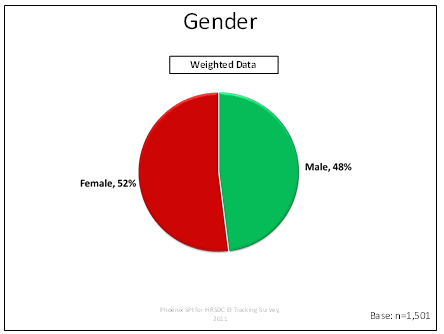
Text description of Figure 74 Gender
Most respondents were 35 or older.
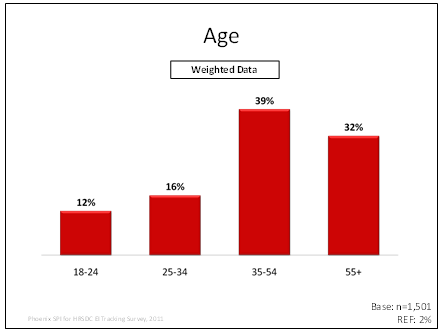
Text description of Figure 75 Age
In order to obtain better accuracy of findings for smaller provinces, the survey used a disproportionately stratified sample approach. As noted, weights were applied to bring the regional distribution in line with the population of Canada.

Text description of Figure 76 Region
Twenty-two percent of respondents completed the survey in French.

Text description of Figure 77 Language
Three-quarters of those surveyed were from urban areas, while 23% were from rural regions.

Text description of Figure 78 Urban-Rural Location
When looking at respondents’ 2010 household incomes, just over one-quarter earned less than $40,000, while the same proportion made between $60,000 and $99,999. Eighteen percent made between $40,000 and $59,999, and almost one-fifth earned $100,000 or more.
Twelve percent chose not to provide an answer to this question.

Text description of Figure 79 Household Income
When it came to respondents’ 2010 personal incomes, just over half earned less than $40,000. Sixteen percent made between $40,000 and $59,999, and approximately one-fifth earned $60,000 or more.
Thirteen percent chose not to provide an answer to this question.
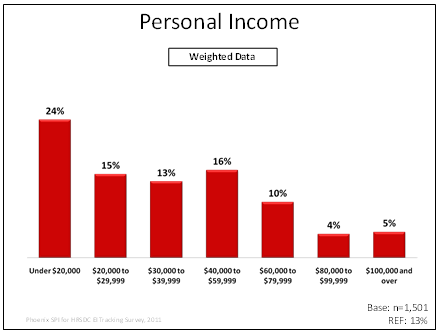
Text description of Figure 80 Personal Income
A majority of those surveyed (52%) completed some form of post-secondary education. Conversely, 22% completed high school, while 10% had less than a high school education. Fifteen percent had enrolled in, but had not completed, a college (7%) or university program (8%).
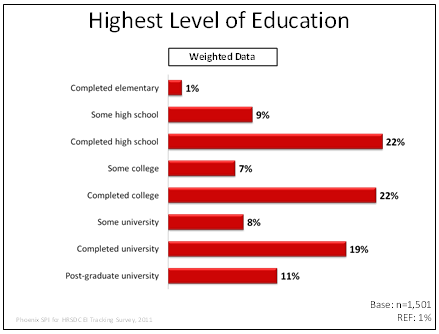
Text description of Figure 81 Highest Level of Education
Almost two-thirds of those surveyed were married or living as a couple (63%), while 23% said they were single. Of the rest, 5% were divorced, 5% were widowed, and 3% were separated from their spouse.
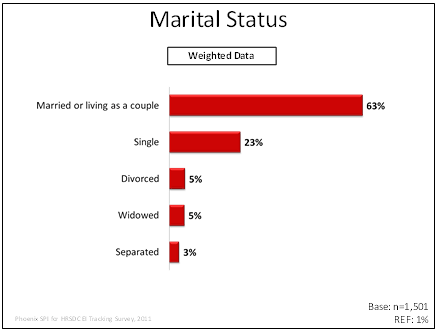
Text description of Figure 82 Marital Status
Over one-third of respondents (38%) had children under the age of 18 living in their household.
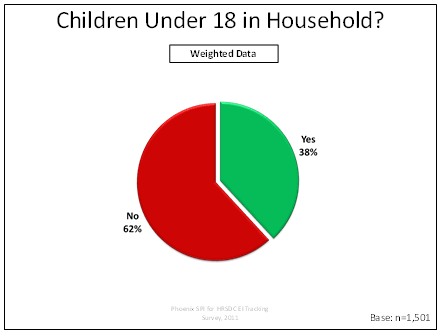
Text description of Figure 83 Children Under 18 in Household?
The large majority of respondents (89%) said they did not have any relatives over the age of 65 living in their household, while 10% indicated that they did.
Most cell phone users (57%) also have a traditional telephone or landline in their household. On the other hand, a substantial minority (43%) do not.
Nearly three-quarters of the traditional telephone users (73%) said that they or someone else in their household also uses one or more cell phone numbers.
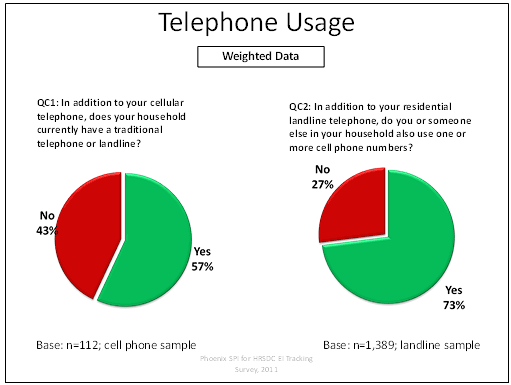
Text description of Figure 84 Telephone Usage
Employed and self-employed respondents work in a variety of sectors/industries.

Text description of Figure 85 Employment Industry
Employed and self-employed respondents are almost equally likely to work for large firms or organizations (i.e. 500 or more employees) or small firms or organizations (i.e. under 50 employees). Just over one in five work for medium-sized firms or organizations (i.e. 50-500 employees).
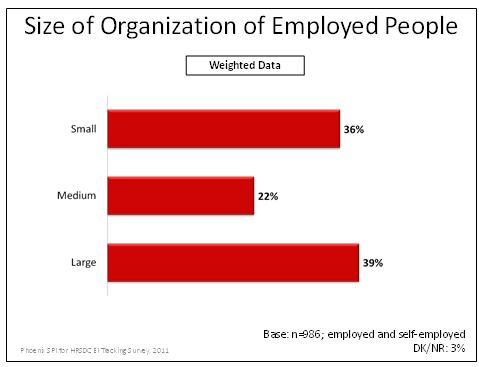
Text description of Figure 86 Size of Organization of Employed People
A dual-mode methodology was used for this research, involving both telephone and online data collection. In addition, the telephone survey included both landline and cell phone samples. This is the first time that cell phones have been included in the sample for this tracking survey. Below we provide details about the methodology, first for the telephone survey and then for the online survey.
A telephone survey was conducted with 1,500 members of the general public, 18 years of age and older. Based on a sample of this size, the overall findings can be considered accurate to within ±2.6%, 19 times out of 20. The margin of error for sub-sets of this population is higher.
The following specifications applied to this research:
| Area | No. of Interviews | Margin of Error95% Confidence Level |
|---|---|---|
| Atlantic Provinces | 200 | ±7.1 |
| Quebec | 350 | ± 5.3 |
| Ontario | 400 | ± 5.0 |
| Prairies | 350 | ±5.3 |
| Manitoba | 100 | ±10.0 |
| Saskatchewan | 100 | ±10.0 |
| Alberta | 150 | ± 8.2 |
| British Columbia | 200 | ± 7.1 |
| Canada | 1,500 | ± 2.6 |
The questionnaire used in 2010 was the basis of this year’s questionnaire. The objectives were to track EI issues from previous research and cover new issues identified by HRSDC officials. In addition, for analytical purposes, the survey included a question about cell phone use; specifically, whether the household has both a landline and a cell phone or a cell phone only and no landline. The same questionnaire was used for both data collection methods, although modifications were needed for its use with the online panel.
Caveat regarding tracking of results: When comparing results over time, it should be kept in mind that the sample for this year’s telephone survey differed from the sample in previous waves in that 20% of this year’s sample consisted of cell phone numbers.
The following table presents information about the final call dispositions for this survey, as well as the associated response rates (using the MRIA formula): The MRIA response rate formula is as follows: [R=R/(U+IS+R)]. This means that the response rate is calculated as the number of responding units [R] divided by the number of unresolved [U] numbers plus in-scope [IS] non-responding households and individuals plus responding units [R]. This information is provided for the telephone survey overall, and for the landline and cell phone samples separately.
| Overall | Landline | Cell | |
|---|---|---|---|
| Total Numbers Attempted | 29747 | 23961 | 5786 |
| Out-of-scope - Invalid | 5541 | 3159 | 2382 |
| Unresolved (U) | 12311 | 9866 | 2445 |
| No answer/Answering machine | 12311 | 9866 | 2445 |
| In-scope - Non-responding (IS) | 1375 | 1258 | 117 |
| Language barrier | 375 | 340 | 35 |
| Incapable of completing (ill/deceased) | 189 | 188 | 1 |
| Callback (Respondent not available) | 811 | 730 | 81 |
| Total Asked | 10520 | 9678 | 842 |
| Refusal | 7872 | 7252 | 620 |
| Termination | 81 | 77 | 4 |
| In-scope - Responding units (R) | 2567 | 2349 | 218 |
| Completed Interview | 1500 | 1388 | 112 |
| NQ - Industry | 144 | 71 | 73 |
| NQ - Less than 18 | 29 | 0 | 29 |
| Quota full | 894 | 890 | 4 |
| Refusal Rate | 75.60 | 75.73 | 74.11 |
| Response Rate | 10.60 | 11.29 | 6.40 |
In addition to the telephone survey, a pilot online panel survey was conducted with Canadian residents, 18 years of age and older. Due to declining telephone response rates HRSDC was interested is exploring whether or not transitioning the study towards an online methodology would be a viable approach. In total, 501 respondents completed the online survey. Since this was not a probability sample, no margin of error can be applied to the research results.
The following specifications applied to the online survey:
The following table presents information about the online response rates (using approach identified in the Standards for the Conduct of Government of Canada Public Opinion Research – Online Surveys).
| Total number of sample units invited to participate (a): | 14490 |
|---|---|
| Invalid (b): | 0 |
| (U) Unresolved | 13835 |
| (IS) In-scope – non responding | 35 |
| (R) In-scope – Responding | 620 |
| Disqualified (f) | 12 |
| Quota Filled (h) | 107 |
| Completed Interviews (d) | 501 |
| Response Rate = R / (U+IS+R) | 4.28% |
| incidence | 80.81% |
3. Demographic and Subgroup Variations
For the demographic and sub-group analyses for the telephone survey, characteristics have been grouped as follows:
When reporting these variations, only differences that are significant at the 95% confidence level are discussed in the report (unless differences are indicative of a pattern).
Hello, my name is_______________ . I’m calling on behalf of Phoenix, a public opinion research firm. We’re conducting a survey for the Government of Canada to explore the attitudes of Canadians concerning Employment Insurance or EI4. The survey is registered with the national survey registration system.
CELL SAMPLE SKIP A AND B, GO TO CS1.
A. We choose telephone numbers at random, then select one person from a household to be interviewed. May I please speak to the person in the household, 18 years of age or older, who has had the most recent birthday? Would that be you? (IF NOT, ASK TO SPEAK TO THAT PERSON AND START AGAIN)
IF NOT AVAILABLE NOW, ASK:
B. When would it be more convenient for me to call back?
Schedule callback if possible (time/day): _______________
CELL SAMPLE ONLY:
CS1. Have I reached you on your cell phone?
CS2. Are you 18 years of age or older?
CS3. Are you in a place where you can safely talk on the phone and answer my questions?
CS4. When would it be more convenient for me to call back?
Schedule callback if possible (time/day): _______________
C. Do you or does anyone in your household work for any of the following types of organizations: an advertising or market research firm, the media, or an elected official?
D. Your participation in this survey is voluntary, but would be extremely helpful. All responses will be kept confidential. The call may be monitored for quality control purposes. Would you be willing to take part in this survey? We can do it now, or is there a better time?
SURVEY LENGTH: IF RESPONDENT ASKS ABOUT THE LENGTH OF THE SURVEY, INFORM HIM/HER THAT IT AVERAGES 15 MINUTES, SOMETIME LESS. THE LENGTH VARIES DEPENDING ON RESPONSES TO SOME OF THE QUESTIONS.
RESEARCH VALIDITY: IF RESPONDENT QUESTIONS THE VALIDITY OF THE RESEARCH, INVITE HIM/HER TO: 1) CALL THE NATIONAL SURVEY REGISTRATION SYSTEM, OR 2) ALEXANDRA HICKEY OF THE GOVERNMENT OF CANADA 1-819-994-2245 OR HAVE ALEXANDRA CALL THE RESPONDENT.
SURVEY REGISTRATION SYSTEM: IF RESPONDENT ASKS ABOUT NATIONAL SURVEY REGISTRATION SYSTEM, SAY:
The registration system has been created by the survey research industry to allow the public to verify that a survey is legitimate, get information about the survey industry or register a complaint. The registration system’s toll-free phone number is 1-800-554-9996.
PRIVACY: PARTICIPANTS’ COMMENTS WILL BE PROTECTED IN ACCORDANCE WITH THE PROVISIONS OF THE PRIVACY ACT. INDICATE THIS IF RELEVANT. ALSO SAY IF RELEVANT: “YOUR REPONSES TO THIS SURVEY WILL HAVE NO IMPACT ON YOUR DEALINGS WITH THE FEDERAL GOVERNMENT.”
HEADINGS IN BLUE SHOULD NOT BE READ TO RESPONDENTS.
UNLESS OTHERWISE SPECIFIED, ALL QUESTIONS IN THE SURVEY WILL ALLOW FOR ‘DON’T KNOW/NO RESPONSE’ OPTION. DK/NR IS ONLY SPECIFIED WHERE IT RELATES TO SKIP LOGIC.
E In what year were you born?
Record year: ____________
1. In your opinion, is… (INSERT FROM BELOW) getting stronger, weaker, or is it staying about the same? (READ/RANDOMIZE LIST)
2. Which of the following best describes your employment status? Are you …? [READ LIST; ACCEPT ONE RESPONSE]
ASK EMPLOYED, UNEMPLOYED, AND SELF EMPLOYED
3. Are you a seasonal employee?
ASK EMPLOYED AND SELF-EMPLOYED
4. a) Is your employment full-time or part-time?
b) How many hours do you work per week?
Record hours: _________
ASK SELF-EMPLOYED ONLY:
4c Is self-employment your main source of personal income? (NOTE: THIS MEANS PERSONAL, NOT HOUSEHOLD INCOME)
4d Do you have employees? (WAS Q6 IN 2010)
4e How long have you been self-employed? (READ LIST IF NECESSARY)
5. Apart from your self-employment, do you also work as an employee for someone else?
6b Does your employer deduct amounts from your pay for programs such as Employment Insurance or the Canada Pension Plan/Quebec Pension Plan*?
*USE QUEBEC PENSION PLAN IN QUEBEC AND CANADA PENSION PLAN IN ALL OTHER LOCATIONS.
7. Are you responsible for managing other employees?
ASK ALL ‘UNEMPLOYED’ AND ‘HOMEMAKERS’:
9. a) Are you …? [READ; ACCEPT ONE RESPONSE]
ASK UNEMPLOYED AND HOMEMAKERS LOOKING FOR WORK:
9 b) How long do you think it will take you to find work? Would you say in the next…? (READ LIST. ACCEPT ONE RESPONSE)
ASK ‘EMPLOYED’:
10. a) Is it very, somewhat, not very or not at all likely that you will lose your job in the next year?
b) If you were to lose your job in the next year, do you think it might be in the next…? (READ LIST. ACCEPT ONE RESPONSE)
11. If you did lose your job, would you be very, somewhat, not very or not at all likely to do each of the following? READ/DO NOT ROTATE LIST
12. On a scale from 1 to 7, where 1 means strongly disagree, 4 is neutral and 7 means strongly agree, how much do you agree or disagree with the following statement(s)* about the Employment Insurance Program? [READ AND ROTATE. MAKE PLURAL FOR EMPLOYED RESPONDENTS]
13. a) Do you think that the Employment Insurance Program is (ROTATE) fair, unfair or neither? [PROBE FOR VERY OR SOMEWHAT]
ASK THOSE WHO SAID ‘SOMEWHAT/VERY UNFAIR’:
15 b) What do you find most unfair about the Employment Insurance program? [DO NOT READ; ACCEPT ONE RESPONSE]
14. From what you know, do you think the (INSERT FROM BELOW/RANDOMIZE ORDER) provided by the Employment Insurance Program is generous, adequate or insufficient? (REPEAT FOR SECOND OPTION)
a) … level of income support…
b) …duration of income support for loss of employment...
16. a) Which view is closer to your own? [ROTATE]
b) What adjustments or changes would you make? [DO NOT READ; ACCEPT ALL THAT APPLY]
18. If you were to lose your job and had a choice in how your benefits were paid, which of the following would you choose?
ASK ‘EMPLOYED’:
19. Are you very, somewhat, not very or not at all aware that eligible workers who have a short-term illness can receive up to 15 weeks of EI sickness benefits?
ASK ALL:
SB1 In the last 10 years, have you ever been absent from work for more than two weeks due to a short-term illness or injury that required a doctor’s certificate? ACCEPT ‘DOES NOT APPLY’ AS SEPARATE RESPONSE FROM ‘DON’T KNOW’ (Q22 IN 2008)
NOTE TO INTERVIEWER: IF RESPONDENT INDICATES THAT THEY HAVE BEEN IN THIS SITUATION ON MORE THAN ONE OCCASION IN THE LAST 10 YEARS, ASK THEM TO FOCUS ON THEIR MOST RECENT ABSENCE FROM WORK WHEN ANSWERING QS. SB2-SB4
IF YES, ASK:
SB2 How long were you off work due to your sickness or injury? (Q23 IN 2008)
Record length of time in weeks: _____________
(VOLUNTEERED: have not yet returned to work)
SB3 When you took time off work due to your illness or injury, did you receive any income support during your absence? (Q24 IN 2008)
IF YES, ASK:
SB4 Did the income support during your absence from work due to an illness or injury come from…? (READ LIST; ACCEPT MULTIPLE RESPONSES) (NEW)
20. Are you very, somewhat, not very or not at all aware that eligible workers can receive some income benefits to take time off work to care for or support a gravely ill or dying family member?
21. Have you ever been in a situation where your job demands were in direct conflict with the need to provide care or support for any of the following… ? [READ/ROTATE]
a) A gravely ill or dying person?
b) Someone with a one-time medical emergency or injury?
c) Someone with a chronic or long term illness?
IF YES IN Q21a, b, OR c:
d) Was the person you cared for a child under 18 years of age?
IF YES IN Q21d
: e) What is your relationship to this child? [DO NOT READ. ACCEPT ONE RESPONSE]
IF YES IN Q.21 a, b, or c CONTINUE; OTHERS GO TO Q.27
22. In order to care for the gravely ill or dying person, did you take time off work?
23. Since you did not take time off work, how was that person cared for? Would you say …? [READ LIST; ACCEPT ALL THAT APPLY]
IF YES IN Q.22 CONTINUE / OTHERS GO TO Q.27
24. How much time off work did you take to care for this person? Was it …? [READ LIST; ACCEPT ONE RESPONSE]
25. When you took time off work to care for this person did you do any of the following? [READ LIST; ACCEPT ALL THAT APPLY]
ASK IF RESPONDENT DOES NOT MENTION Q.25 CODE 6:
26. Why did you not use the Compassionate Care benefits? [DO NOT READ; ACCEPT ALL THAT APPLY]
27. In the future, if you were working and you were faced with a situation where you needed to take time away from work to care for or support a gravely ill family member, how likely would you be to apply for Compassionate Care Benefits? These benefits allow Canadians to take a temporary leave from work, up to 6 weeks, to provide care or support to a gravely ill family member.
IF NOT VERY LIKELY OR NOT AT ALL LIKELY, ASK:
28. What would be the main reason you would not apply? [DO NOT READ; ACCEPT ONE RESPONSE]
READ PREAMBLE EVERYWHERE EXCEPT IN QUEBEC
The Government of Canada passed legislation which provides Employment Insurance maternity, parental, sickness and compassionate care benefits to self-employed Canadians on a voluntary basis. As of January 31, 2010, the self-employed have been able to opt into the Employment Insurance program by registering through Service Canada. If they opted in on or before April 1, an individual will be able to make a claim for Employment Insurance benefits as early as January 2011. The premiums will be the equivalent rate that salaried employees currently pay.
READ PREAMBLE IN QUEBEC ONLY
The Government of Canada passed legislation which provides Employment Insurance maternity, parental, sickness and compassionate care benefits to self-employed Canadians on a voluntary basis. The self-employed living in Quebec continued to receive maternity and parental benefits through the Quebec Parental Insurance Plan, and as of January 31, 2010, were eligible to opt into the Employment Insurance program for sickness and compassionate care benefits by registering through Service Canada. If they opted in on or before April 1, an individual will be able to make a claim for Employment Insurance benefits as early as January 2011. The premiums will be the equivalent rate that salaried employees currently pay.
SE1 Were you aware of this new measure? (READ LIST)
ASK SELF-EMPLOYED
The next few questions are for people like you who are self-employed.
SE2 Do you intend to opt into the Employment Insurance program to take advantage of this new measure for the self-employed? (READ LIST)
IF YES, ASK NEXT QUESTION:
SE3 What is your primary reason for opting into the Employment Insurance program? Any other reasons (DO NOT READ LIST. ACCEPT ALL THAT APPLY)
IF NO, ASK: SE6
What is your main reason for not opting into the Employment Insurance program? Any other reasons (DO NOT READ LIST. ACCEPT ALL THAT APPLY)
Work-Sharing is an adjustment program under the Employment Insurance program that is designed to help employers and employees avoid temporary layoffs. The measure provides income support to employees eligible for Employment Insurance benefits who work a temporarily-reduced work-week.
WS1 Were you aware of the Work-Sharing program? READ LIST
T1 If you were receiving Employment Insurance because you lost your job, how interested would you be in taking training to improve your skills? Would you say very interested, moderately, not very or not at all interested?
IF NOT VERY OR NOT AT ALL INTERESTED, ASK:
T2 Why would you not be interested in taking training? (DO NOT READ, ACCEPT ALL THAT APPLY)
R1 In your view, how well did the Employment Insurance Program respond in terms of helping people who lost their jobs during the recession of 2008/2009? Would you say that, overall, the EI program responded…? [READ LIST, ACCEPT ONE RESPONSE]
ASK THOSE WHO RESPONDED “NOT VERY WELL/ NOT WELL AT ALL”:
R2 How could the EI program have performed better? (DO NOT READ, ACCEPT ALL THAT APPLY)
37. How many times have you received Employment Insurance benefits in the last five years?
38. Why did you receive Employment Insurance benefits? Was it …? [READ LIST; ACCEPT MULTIPLE RESPONSES]
39. While receiving Employment Insurance benefits during the last five years, did you move to find work?
ASK ALL:
40. Has anyone else in your household received Employment Insurance benefits in the last five years?
41. Why did this other person receive Employment Insurance benefits? Was it …? [READ LIST; ACCEPT MULTIPLE RESPONSES]
Now, I would like to get some information to help us group your answers with others that we will receive in this survey.
43. What is the highest level of education that you have reached? [DO NOT READ; ACCEPT ONE RESPONSE]
*NOTE: INCLUDES LEGAL, MEDICAL, ACCOUNTING AND SIMILAR OCCUPATIONS.
ASK EMPLOYED AND SELF-EMPLOYED:
44. In what industry do you work? [DO NOT READ; ACCEPT ONE RESPONSE]
45. Do you work for a small (<50 employees), medium (50-500) or large (500+) firm or organization?
ASK ALL:
46. Are you …? [READ LIST; ACCEPT ONE RESPONSE]
47. Are there any children in your household under the age of 18? This includes children living with you full-time or part-time as part of a shared-custody arrangement. [READ LIST; ACCEPT ONE RESPONSE]
48. Are there any adults in your household over the age of 65 to whom you are related? [READ LIST; ACCEPT ONE RESPONSE]
Which of the following best corresponds to the total annual income, before taxes, of all members of your household for 2010? Please stop me once your category is reached. [READ LIST; ACCEPT ONE RESPONSE]
50. And what is your personal income, before taxes, for 2010? Please stop me once your category is reached. Is it…? [READ LIST; ACCEPT ONE RESPONSE]
ASK CELL SAMPLE:
C1. In addition to your cellular telephone, does your household currently have a traditional telephone or landline? [READ LIST; ACCEPT ONE RESPONSE]
ASK LANDLINE SAMPLE:
C2. In addition to your residential landline telephone, do you or someone else in your household also use one or more cell phone numbers? [READ LIST; ACCEPT ONE RESPONSE]
51. For verification purposes, what are the first three digits of your postal code? ________ That concludes the survey.
Thank you very much for your thoughtful feedback.
It is much appreciated.
1 Please note that throughout the report the category "employed" refers to persons working for an employer, employed students, and persons on temporary leave from their jobs, while the term "self-employed" refers to persons who are self-employed, as well as self-employed persons who are also working for an employer.
2 Note the relatively small base (n = 96) and exercise caution when interpreting these data.
3 Please see Footnote 1 for definition of the terms “employed” and “self-employed” used elsewhere in this report.
4 If respondent appears confused about this program, or asks for clarification, please say that Employment Insurance was previously called Unemployment Insurance or UI.